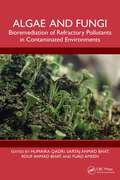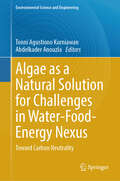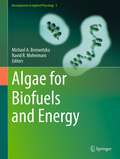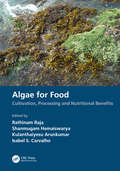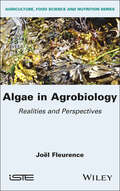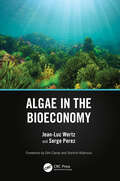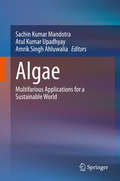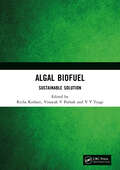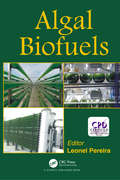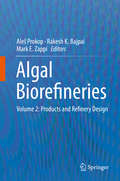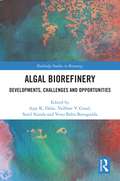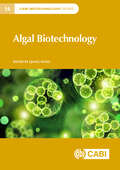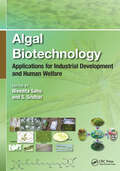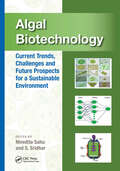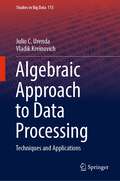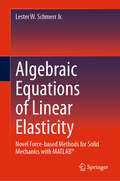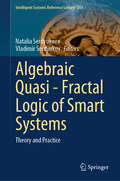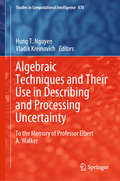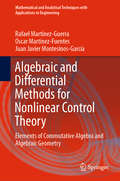- Table View
- List View
Algae and Fungi: Bioremediation of Refractory Pollutants in Contaminated Environments
by Humaira Qadri Rouf Ahmad Bhat Sartaj Ahmad Bhat Fuad AmeenThis book discusses algae and fungi as the tools for decontamination of polluted environments and how the remediation techniques aid in biorefining the pollution in environmentally sustainable ways. It covers their applications in containing and controlling pollution along with detailed diagrammatic representations including mechanisms of phyco- and myco-remediation. Recovery of pollutants including heavy metals, pesticides, organic chemicals, radionuclides, and persistent chemicals from polluted ecosystems and wastewater is also covered. Exclusively covers phyco- and myco-remediation of various pollutants Reviews dynamics of pollution abatement related to algae as well as fungi Covers recovery of the pollutants from polluted ecosystems Advocates usage of multiple modes of fungi and algae for detoxification of different compounds Discusses restoration of the degraded ecosystems This book is aimed at researchers and graduate students in environmental engineering, algae and fungi biotechnology, applied microbiology, and phycology.
Algae and Sustainable Technologies: Bioenergy, Nanotechnology and Green Chemistry
by Atul Kumar Upadhyay D. P. SinghAlgal and sustainable technologies: Bioenergy, Nannotechnology and Green chemistry is an interdisciplinary overview of the world’s major problems; water scarcity, clean environment and energy and their sustenance remedy measures using microalgae. It comprehensively presents the way to tackle the socio-economic issues including food, feed, fuel, medicine and health and also entails the untapped potential of microalgae in environmental management, bioenergy solution and sustainable synthesis of pharmaceutical and nutraceutical products. This book basically emphasizes the success of algae as wonderful feed stocks of future and provides upto date information and sustainable and recreational outlook towards degrading environment and energy crisis. Applicability of fast emerging algae based nanotechnology in bioremediation and production of nanoparticle (AuNP, AgNP etc) are beautifully described along with latest research and findings. Key features: The "waste to best to income" strategies are the main concern of the book and take the edge off the problem of pollution, energy and income. Elucidate the sustainable phycoremediation and nanoparticle functions as low cost approach for various ecosystem services. Information regarding pharmaceuticals, nutraceuticals and other algae based value added product synthesis and fate are comprehensively discussed. Knowledge resource, latest research, findings and prospects presented in an accessible manner for researchers, students, eminent scientists, entrepreneurs, professionals and policy maker.
Algae as a Natural Solution for Challenges in Water-Food-Energy Nexus: Toward Carbon Neutrality (Environmental Science and Engineering)
by Abdelkader Anouzla Tonni Agustiono KurniawanThis book provides an overview of challenges and opportunities for algal management to mitigate climate change. This book offers new perspectives on how to control water pollution due to algae, while converting it to biosorbent and biodiesel that could be sold in market. The work also explores how to improve the performance of algae for such purposes. By identifying existing knowledge gap, this work uncovers new research directions for further development of algal management to address global environmental pollution. • Extensive literature survey (2001-2023) in algal management based on empirical approach in the body of knowledge • A comprehensive overview with critical analysis of algal management, for water treatment, biodiesel production, and food production, while dealing with climate change • Providing insights about challenges, research direction, outlook, and perspectives of algal management in Industry 4.0 era This book has an advantage that each chapter will be written by experts around the world working in their respective fields. As a result, this volume presents a balanced picture across the whole spectrum of algae. Furthermore, the authors are from both the developing and developed countries thus giving a worldwide perspective of looming climatic problems.
Algae for Biofuels and Energy (Developments in Applied Phycology #5)
by Navid R. Moheimani Michael A. BorowitzkaMicroalgae are one of the most studied potential sources of biofuels and bioenergy. This book covers the key steps in the production of renewable biofuels from microalgae - strain selection, culture systems, inorganic carbon utilisation, lipid metabolism and quality, hydrogen production, genetic engineering, biomass harvesting, extraction. Greenhouse gas and techno-economic modelling are reviewed as is the 100 year history of microalgae as sources of biofuels and of commercial-scale microalgae culture. A summary of relevant basic standard methods used in the study of microalgae culture is provided. The book is intended for the expert and those starting work in the field.
Algae for Food: Cultivation, Processing and Nutritional Benefits
by Shanmugam Hemaiswarya Rathinam Raja Kulanthaiyesu Arunkumar Isabel S. CarvalhoAlgae for Food: Cultivation, Processing and Nutritional Benefits Algae are a primitive, living photosynthetic form and they are the oldest living organism. In the marine ecosystem, algae are the primary producers that supply energy required to a diverse marine organism and especially seaweed provides a habitat for invertebrates and fishes. There have been significant advances in many areas of phycology. This book describes the advances related to food and nutrition of algae achieved during the last decades, it also identifies gaps in the present knowledge and needs for the future. The 17 chapters, grouped into 6 parts, are written by phycologists. More insight on industrial exploitation of algae and their products is supported by current studies and will help academia. The first part explains new technologies to improve the microalgal biomass, strain improvement and different methods of seaweed cultivation. In the second part, food and nutraceutical applications of algae, food safety aspects, green nanotechnology and formulation methods for the extraction and isolation of algal functional foods are described. The third part deals with pigments and carotenoids while the fourth part exploits the isolation and application of hydrocolloids, nutritional implications of algal polysaccharides and the characterization and bioactivity of fucoidans. In the fifth part, the biomedical potential of seaweed followed by agricultural applications of algae are well described. The book is an important resource for scholars that provides knowledge on wide range of topics. Key Features Covers important fields of algae from biomass production to genetic engineering aspects of algae Useful in the field of algal biotechnology, aquaculture, marine micro and macrobiology, microbial biotechnology and bioprocess technology Focuses on the therapeutic and nutritional areas of algae
Algae in Agrobiology: Realities and Perspectives
by Joel FleurenceAlgae, macroalgae and microalgae can be valuable biological resources in a new, more environmentally friendly form of agriculture known as agrobiology. Indeed, the biological properties associated with algae are frequently relevant for agricultural and zootechnical purposes. It is this aspect that is behind the current popularity of algae in the development of new agricultural practices that are related to plant and animal production, which are referred to as agrobiology. Algae in Agrobiology offers a current and forward-looking account of algae use: in agriculture and in the sector of land and marine animal production, as algal extracts and molecules in the form of fertilizers or biostimulants for crops with agronomic interest, and as algal compounds in the area of plant and animal health. This book is based on advances in biochemical and agronomic research in order to explain the conventional practices associated with the use of algae in agriculture and livestock breeding. These advances make it possible to establish possible uses for marine algal resources in the agriculture of the future.
Algae in the Bioeconomy
by Jean-Luc Wertz Serge PerezAlgae play an important ecological role as oxygen producers and carbon sequesters and are the food base for all aquatic life. Algae are economically important as a source of crude oil, food and feed, and pharmaceutical and industrial products. High-value and sustainable products from algae are already economically viable and can be a fundamental driver for fuel production. Algae in the Bioeconomy provides a detailed overview of the chemical composition of algae and shows that an integrated biorefinery approach is necessary for large-scale algae production and conversion, where multiple products are produced. This book serves as a unique compendium of knowledge covering the essential features of algae and their applications. Discusses the structural chemistry and biology of micro- and macroalgal components Describes classification, occurrence, conversion, and production of micro- and macroalgae Offers strategies for optimal use of micro- and macroalgae in the bioeconomy, including regional strategies in the EU, US, China, India, Malaysia, Norway, and Chile Features forewords from international experts offering both a scientific and an economic/strategic viewpoint This book is intended for an interdisciplinary audience in chemical engineering, biotechnology, and environmental science and engineering, promoting research, development, and application of algae as a sustainable resource.
Algae: Multifarious Applications for a Sustainable World
by Atul Kumar Upadhyay Sachin Kumar Mandotra Amrik Singh AhluwaliaThis exciting book presents diverse applications of microalgal renewable resources to meet modern demands for energy and value-added products. It also comprehensively describes the role of algae in sustainable and cost-effective wastewater treatment strategies, and highlights the latest research on, advances in and biotechnological relevance of algae in the areas of bioenergy, bioremediation, pharmaceuticals, nutraceuticals and green economy. The book addresses gaps in the fields of bioenergy, waste management, health and economy by providing broad information on bioenergy production, management strategies, drug development, nutraceuticals products and biobased economy using algae at the commercial level. The book introduces researchers to key and emerging innovations in the field of algal biology research and will assist policymakers, environmentalists, scientists, students and global thinkers in defining sustainable developmental goals for the future. Accordingly, it is an extremely important read for researchers and students in the environmental sciences, life sciences and chemistry, experts in the energy sector and policymakers alike.
Algal Biofuel: Sustainable Solution
by Richa Kothari V. V. Tyagi Vinayak V. PathakAlgal Biofuel: Sustainable Solution primarily focuses on the different aspects of bioenergy production using algal biomass as microalgae are considered the optimum feedstock for bioenergy production. The major aim is to thoroughly review the available bioenergy options, challenges in bioenergy production, availability of bioenergy feedstock, and biomass to bioenergy conversion process. This book also highlights the feasibility of lignocellulosic biomass, crop residues, and non-edible oil seeds for generation of different bioenergy products. It will be helpful for researchers and other stakeholders working in the area of bioenergy production for development of innovative concepts in emerging areas of bioenergy. Print edition not for sale in South Asia (India, Sri Lanka, Nepal, Bangladesh, Pakistan and Bhutan).
Algal Biofuels
by Leonel PereiraAlgae presents a viable biofuel alternative because the production of algae for fuel, unlike other agro-based biofuels, does not compete with food production. This book covers algae-based biofuel options and discusses the design and economic viability of algal bioenergy co-production concepts.
Algal Biofuels: Recent Advances and Future Prospects
by Faizal Bux Sanjay Kumar Gupta Anushree MalikThis edited volume focuses on comprehensive state-of-the-art information about the practical aspects of cultivation, harvesting, biomass processing and biofuel production from algae. Chapters cover topics such as synthetic ecological engineering approaches towards sustainable production of biofuel feedstock, and algal biofuel production processes using wastewater. Readers will also discover more about the role of biotechnological engineering in improving ecophysiology, biomass and lipid yields. Particular attention is given to opportunities of commercialization of algal biofuels that provides a realistic assessment of various techno-economical aspects of pilot scale algal biofuel production. The authors also explore the pre-treatment of biomass, catalytic conversion of algal lipids and hydrothermal liquefaction with the biorefinery approach in detail. In a nut shell, this volume will provide a wealth of information based on a realistic evaluation of contemporary developments in algal biofuel research with an emphasis on pilot scale studies. Researchers studying and working in the areas of environmental science, biotechnology, genetic engineering and biochemistry will find this work instructive and informative.
Algal Biorefineries: Volume 1: Cultivation of Cells and Products
by Aleš Prokop Rakesh Bajpai Mark ZappiThis book reviews efforts to produce chemicals and fuels from forest and plant products, agricultural residues and more. Algae can potentially capture solar energy and atmospheric CO2; the book details needed research and legislative initiatives.
Algal Biorefineries: Volume 2: Products and Refinery Design
by Aleš Prokop Rakesh K. Bajpai Mark E. ZappiAlgae offer potential to produce renewable chemicals and fuels using solar energy and carbon dioxide from atmosphere or in flue gases while simultaneously reducing the generation of greenhouse gases. Since these can be grown on marginal lands with micronutrients and macronutrients often present in waste streams, algae-based chemicals and fuels do not compete with foods. Still large-scale production of algae-based fuels and chemicals faces considerable technological and economical challenges and it would by necessity require a biorefinery approach wherein all the possible algal components are converted into value-added compounds. The present series on algal biorefineries represents a forum for reporting the state of the art of different technologies as well as the latest advances in this field. The volume II of this series complements the volume I in terms of the current state of the art. Different chapters in this volume address diverse issues ranging from genetically modifies algae to new products to life-cycle analysis of algal products.
Algal Biorefinery: An Integrated Approach
by Debabrata DasThis book critically discusses different aspects of algal production systems and several of the drawbacks related to microalgal biomass production, namely, low biomass yield, and energy-consuming harvesting, dewatering, drying and extraction processes. These provide a background to the state-of-the-art technologies for algal cultivation, CO2 sequestration, and large-scale application of these systems. In order to tap the commercial potential of algae, a biorefinery concept has been proposed that could help to extract maximum benefits from algal biomass. This refinery concept promotes the harvesting of multiple products from the feedstock so as to make the process economically attractive. For the last few decades, algal biomass has been explored for use in various products such as fuel, agricultural crops, pigments and pharmaceuticals, as well as in bioremediation. To meet the huge demand, there has been a focus on large-scale production of algal biomass in closed or open photobioreactors. Different nutritional conditions for algal growth have been explored, such as photoautotrophic, heterotrophic, mixotrophic and oleaginous. This book is aimed at a wide audience, including undergraduates, postgraduates, academics, energy researchers, scientists in industry, energy specialists, policy makers and others who wish to understand algal biorefineries and also keep abreast of the latest developments.
Algal Biorefinery: Developments, Challenges and Opportunities (Routledge Studies in Bioenergy)
by Sonil Nanda Ajay K. Dalai Vaibhav V. Goud Venu Babu BorugaddaThis book enables readers to understand the theoretical aspects, key steps and scientific techniques with a detailed mechanism to produce biofuels from algae. Each chapter provides the latest developments and recent advancements starting from algal cultivation techniques to the production of value-added green fuels, chemicals and products with wide applications. The volume brings together a broad range of international and interdisciplinary experts, including chemical and biological engineers, biotechnologists, process engineers, environmentalists, pharmacists and nutritionists, to one platform to explore the beneficial aspects and challenges for an algal-based biorefinery. Chapters address cutting-edge issues surrounding algal cultivation, including genetic modification of algal strains, design and optimization of photobioreactors and open-pond systems, algal oil extraction techniques and algal-derived fuel products (biodiesel, bio-gasoline, jet fuels and bio-oil). Finally, the book considers the potential environmental impacts for establishing a sustainable algal biorefinery through lifecycle analysis, techno-economic assessment and supply chain management. This book will be an important resource for students, academics and professionals interested in algal cultivation, biofuels and agricultural engineering, and renewable energy and sustainable development more broadly.
Algal Biotechnology (CABI Biotechnology Series)
by Sanjay Gupta Jin Wang Vinod Kumar Xu Zhang Lei Chen Chao Li Weiwen Zhang Xinyu Song Xiaojun Yan Chengxu Zhou Roger Ruan Yahui Bo Gao Chen Zhenfan Chen Zixi Chen Pengfei Cheng Feng Ge Jiameng Guo Xiahui Hao Qingfang He Fan Hu Hanhua Hu Krishna Kumar Jaiswal Hu Jin Anping Lei Anna I. Kurbatova Yanhua Li Hanzhi Lin Lu-Ning Liu Qiong Liu Yandu Lu Anastasios Melis Yufang Pan Vishal Rajput Shengzhou Shan Kaitlin Simmons Xiaotong Song Adamu Yunusa Ugya Mikhail S. Vlaskin Chun Wang Jiangxin Wang Wenxiu Yin Xiangxiang Zhang Yu-Zhong Zhang Long-Sheng Zhao Quanyu Zhao Yali Zhu Zhu Zhen Tian Jing Cao XupengAlgae are sunlight-driven cell factories, and can efficiently absorb CO2 and convert light energy to chemical energy such as lipid, starch and other carbohydrates and release O2. Algal feedstock is a promising resource for bioproduct production, given its high photosynthetic efficiency for producing biomass compared to conventional crops. Microalgae can be used for flue-gas and wastewater bioremediation. This book highlights recent breakthroughs in the multidisciplinary areas of algal biotechnology and the chapters feature recent developments from cyanobacteria to eukaryotic algae, from theoretical biology to applied biology. It also includes the latest advancements in algal-based synthetic biology, including metabolic engineering, artificial biological system construction and green chemicals production. With contributions by leading authorities in algal biotechnology research, it is a valuable resource for graduate students and researchers in the field, and those involved in the study of photosynthesis and green-cell factories.
Algal Biotechnology: Applications for Industrial Development and Human Welfare
by S. Sridhar Nivedita SahuThis book deals with an interdisciplinary approach towards present-day practical challenges and recent developments in algal biotechnology and covers a broad spectrum of issues ranging from diverse algae and its applications in agriculture, human food, animal feed, wastewater treatment, and industry to algal metabolites. Major themes covered in this volume include algae-based processes for the treatment of industrial effluents, algal biorefinery, industrial trends, and applications of algae in food, feed, nutraceuticals, and pharmaceuticals.Features: Explores the possibility of utilization of algae in human food and pharmaceutical compounds. Presents recent state of the art of design and tools in algal biorefineries. Reviews concepts of membrane bioreactors and microbial fuel cells, including their process and performance. Algae-based technologies for safe and eco-friendly processes to promote a sustainable bio-economy. Discusses algae as a source for potential aquafeed. This book is aimed at graduate students and researchers in biotechnology, bioenergy , renewable energy, energy, fuel and petrochemicals, wastewater, novel technologies, clean technologies, bioremediation environmental biotechnology, functional foods and nutraceuticals, and marine and aquatic science.
Algal Biotechnology: Current Trends, Challenges and Future Prospects for a Sustainable Environment
by S. Sridhar Nivedita SahuThis book initiates with a general introduction to microalgae and algal biotechnology with subsequent discussions on all the significant aspects of applied biotechnology, bioremediation, nano applications, multidimensional usages of algae as a biofertilizer, and a source of bioactive compounds and phytochemicals. Major themes of the book include algae and the environment, bioremediation using algae, algal-omics and applications, and large-scale bioprocesses for algal cultivation, its constraints and challenges.Features: Focusses on the importance of algae for a sustainable environment Covers algal bioplastics and other commercial products Explores possible utilization of algae in phyco/bioremediation Reviews algae as a biostimulant and biofertilizer Demonstrates challenges during algal cultivation on a large scale This book is aimed at graduate students and researchers in biotechnology, bioenergy, renewable energy, energy, bioremediation, fuel and petrochemicals, wastewater, novel technologies, clean technologies, bioremediation environmental, functional foods and nutraceuticals, marine and aquatic science.
Algebraic Approach to Data Processing: Techniques and Applications (Studies in Big Data #115)
by Vladik Kreinovich Julio C. UrendaThe book explores a new general approach to selecting—and designing—data processing techniques. Symmetry and invariance ideas behind this algebraic approach have been successful in physics, where many new theories are formulated in symmetry terms. The book explains this approach and expands it to new application areas ranging from engineering, medicine, education to social sciences. In many cases, this approach leads to optimal techniques and optimal solutions. That the same data processing techniques help us better analyze wooden structures, lung dysfunctions, and deep learning algorithms is a good indication that these techniques can be used in many other applications as well. The book is recommended to researchers and practitioners who need to select a data processing technique—or who want to design a new technique when the existing techniques do not work. It is also recommended to students who want to learn the state-of-the-art data processing.
Algebraic Codes for Data Transmission
by Richard E. BlahutThe need to transmit and store massive amounts of data reliably and without error is a vital part of modern communications systems. Error-correcting codes play a fundamental role in minimising data corruption caused by defects such as noise, interference, crosstalk and packet loss. This book provides an accessible introduction to the basic elements of algebraic codes, and discusses their use in a variety of applications. The author describes a range of important coding techniques, including Reed-Solomon codes, BCH codes, trellis codes, and turbocodes. Throughout the book, mathematical theory is illustrated by reference to many practical examples. The book was first published in 2003 and is aimed at graduate students of electrical and computer engineering, and at practising engineers whose work involves communications or signal processing.
Algebraic Equations of Linear Elasticity: Novel Force-based Methods for Solid Mechanics with MATLAB®
by Lester W. Schmerr Jr.This book describes a second-generation force-based method emerging from a general formulation where the partial differential equations of elasticity are replaced by equivalent algebraic equations. These algebraic equations of linear elasticity can be used to solve statically indeterminate problems in reduced forms that define either the new second-generation force-based approach or a new displacement-based approach. The new force-based method can serve as the basis for teaching students at many technical levels how to solve equilibrium problems directly for the forces present. In elasticity courses, the derivation and use of the algebraic equations of linear elasticity can show how the difficulties of dealing with partial differential equations may be avoided by transforming those equations into algebraic equations with work-energy concepts. In a finite element course, a force-based finite element method can be described along with the traditional displacement-based approach to demonstrate how the two methods provide alternative ways for solving complex structural problems. Serving as a resource for including second-generation force-based methods in solid mechanics courses of an engineering curriculum, and as a robust learning resource, the book is ideal for instructors and for students, practicing engineers, and researchers.
Algebraic Identification of Smart Systems: Theory аnd Practice (Intelligent Systems Reference Library #191)
by Natalia A. Serdyukova Vladimir I. SerdyukovThis book is a continuation of our recently published book “Algebraic formalization of smart systems. Theory and practice.” It incorporates a new concept of quasi-fractal algebraic systems, based on A.I. Maltsev’s theory of algebraic systems and the theory of fractals developed by Benoit Mandelbrot, to investigate smart systems in more detail. The main tool used in the book, quasi-fractal algebraic systems, helps us to see smart systems in more detail by adding new factors, which e.g. make it possible to describe the previously indivisible elements of the initial model of factors. The techniques presented include fixed-point theorem, theorems of group theory, theory of Boolean algebras, and Erdös-Renyi algorithms. Given its focus, the book is intended for anyone interested in smart system theory.
Algebraic Quasi—Fractal Logic of Smart Systems: Theory and Practice (Intelligent Systems Reference Library #251)
by Natalia Serdyukova Vladimir SerdyukovThis book is a continuation of the Algebraic Formalization of Smart Systems. Theory and Practice, 2018, and Algebraic Identification of Smart Systems. Theory and Practice, 2021. Algebraic logic refers to the connection between Boolean algebra and classical propositional calculus. This connection was discovered by George Boole and then developed by other mathematicians, such as C. S. Peirce and Ernst Schroeder. This trend culminated in the Lindenbaum-Tarski algebras. Here we try to connect algebraic logic and quasi-fractal technique, based on algebraic formalization of smart systems to get facts about smart systems functioning and connections of their qualitative and quantitative indicators. Basic techniques we used: algebraic quasi-fractal systems, Erdős–Rényi algorithm, a notion of –giant component of an algebraic system, fixed point theorem, purities, i.e., embeddings preserving -property of an algebraic system. The book is aimed for all interested in these issues.
Algebraic Techniques and Their Use in Describing and Processing Uncertainty: To the Memory of Professor Elbert A. Walker (Studies in Computational Intelligence #878)
by Vladik Kreinovich Hung T. NguyenThis book discusses heuristic methods – methods lacking a solid theoretical justification – which are ubiquitous in numerous application areas, and explains techniques that can make heuristic methods more reliable. Focusing on algebraic techniques, i.e., those that use only a few specific features of a situation, it describes various state-of-the-art applications, ranging from fuzzy methods for dealing with imprecision to general optimization methods and quantum-based methods for analyzing economic phenomena. The book also includes recent results from leading researchers, which could (and hopefully will) provide the basis for future applications. As such, it is a valuable resource for mathematicians interested in potential applications of their algebraic results and ideas, as well as for application specialists wanting to discover how algebraic techniques can help in their domains.
Algebraic and Differential Methods for Nonlinear Control Theory: Elements of Commutative Algebra and Algebraic Geometry (Mathematical and Analytical Techniques with Applications to Engineering)
by Rafael Martínez-Guerra Oscar Martínez-Fuentes Juan Javier Montesinos-GarcíaThis book is a short primer in engineering mathematics with a view on applications in nonlinear control theory. In particular, it introduces some elementary concepts of commutative algebra and algebraic geometry which offer a set of tools quite different from the traditional approaches to the subject matter. This text begins with the study of elementary set and map theory. Chapters 2 and 3 on group theory and rings, respectively, are included because of their important relation to linear algebra, the group of invertible linear maps (or matrices) and the ring of linear maps of a vector space. Homomorphisms and Ideals are dealt with as well at this stage. Chapter 4 is devoted to the theory of matrices and systems of linear equations. Chapter 5 gives some information on permutations, determinants and the inverse of a matrix. Chapter 6 tackles vector spaces over a field, Chapter 7 treats linear maps resp. linear transformations, and in addition the application in linear control theory of some abstract theorems such as the concept of a kernel, the image and dimension of vector spaces are illustrated. Chapter 8 considers the diagonalization of a matrix and their canonical forms. Chapter 9 provides a brief introduction to elementary methods for solving differential equations and, finally, in Chapter 10, nonlinear control theory is introduced from the point of view of differential algebra.
